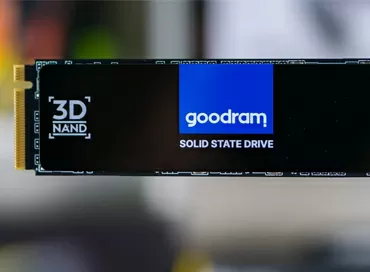Review of GoodRAM CX400 gen2 1 TB SATA SSD
SSD drives of SATA 2.5-inch format are gradually moving away from the central bands of publications, since the maximum interface speed of 600 MB/ s is in no way comparable to those luxurious figures that demonstrate NVME SSDs with a linear speed of 4-5 GB/s. But at the same time, for file washing, for video surveillance systems, and just for old PCs in which the M.2 slot is occupied by a system disk, a SATA drive is the best option, and the prices for 1 TB models are already quite acceptable, thanks to 3D NAND TLC.
The GoodRAM CX400 Gen2 model is positioned precisely as a replacement for HDD in laptops and desktops. It is built on the basis of the PHISON PS3111-S11 controller, has a claimed read speed of up to 550 MB/s, write speed of up to 500 MB/s and a 720 TB resource. The drive is available in an all-in-one plastic case with a height of 7 mm. Interestingly, judging by the characteristics, this model has an extended temperature range, and can operate at ambient temperatures from 0 to 70 degrees Celsius. This is important not only for gaming laptops, but also for desktops. Such an air temperature is not found in computers, so an SSD can be placed in closed niches of the case, and somewhere on the power supply, if you want to hide it along with the wires out of sight. It is also possible to use the drive in various embedded automation systems operating without forced ventilation.
Here I would like to note that the GoodRAM CX400 Gen2 does not have a built-in thermal sensor: no matter what you do with the drive, its temperature readings will always stand at 33 degrees Celsius. Some kind of savings on matches...
Software
From the manufacturer's website, you can download the GoodRAM Optimum SSD Tool, a program that updates the firmware of the drive, as well as tracks SMART indicators.
Among the useful functions is the transfer of information from HDD to SSD, for the implementation of which you need to register the utility by the serial number of the SSD drive.
Testing
First of all, let's start with the much-loved test package CrystalDisk Benchmark, which I always recommend not to use for SSD drives, because its results are far from reality.
The read and write speed is about 480 MB/s, which is typical for modern SATA drives. Let's see how this speed is distributed over time, depending on the loads. To do this, we will use the IOMeter 1.1 test package with a random recording pattern. The tested drive will be 74% full, and the test area will be 15% of the total disk volume. The test time is 300 seconds, and as a comparison we will use the GoodRAM PX500 NVME drive with a capacity of 512 GB, which we reviewed earlier.
Let's start with sequential recording, where the SLC cache usually shows itself so clearly. Even on a logarithmic scale, it can be seen that the SATA drive is not inferior to the NVME analog, and the minimum speed is devoid of dips up to 29 MB/s, as it happens.
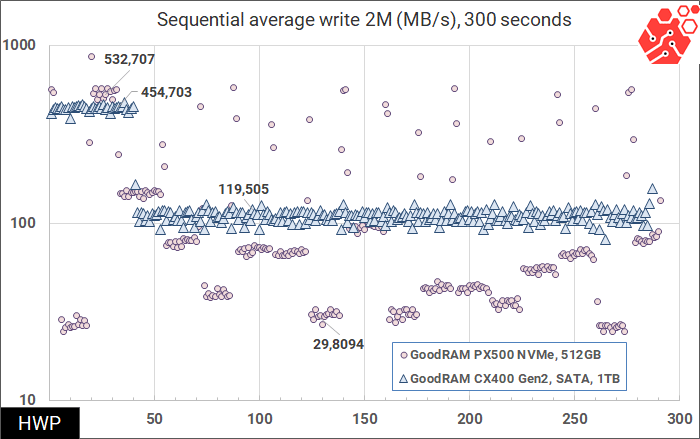
In principle, the SLC cache ends after about 40 seconds of intensive recording, that is, its volume is about 18-20 GB, but then the write speed is quite even, in the range from 79 to 120 MB/s. Let's see what happens when reading.

Yes, of course, the SATA interface here acts as a flash memory speed limiter. There are no surprises for us here. But let's take a break from megabytes per second for a while and look at the responsiveness of the drive with random access. In 4K Random write operations, our test subject shows a surprisingly low latency, consistently holding below 0.1 ms for almost the entire test time.
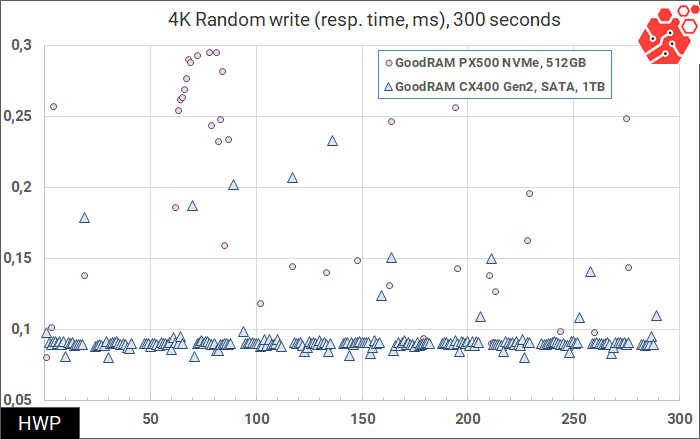
The same stability is maintained in random read operations, and here again our test subject wins against his NVME counterpart.
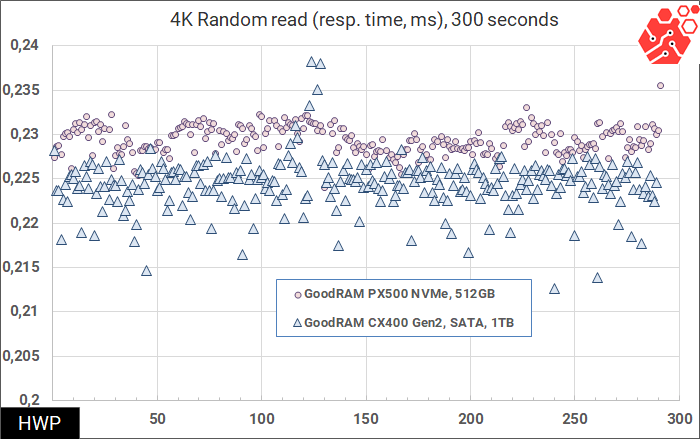
It is the delay in writing and reading that determines how fast the drive will pull games and ordinary office applications, to the patterns of which we are moving. First of all, backup, backup to SSD, because no matter how strange it may look, solid-state drives replace hard drives in these scenarios.
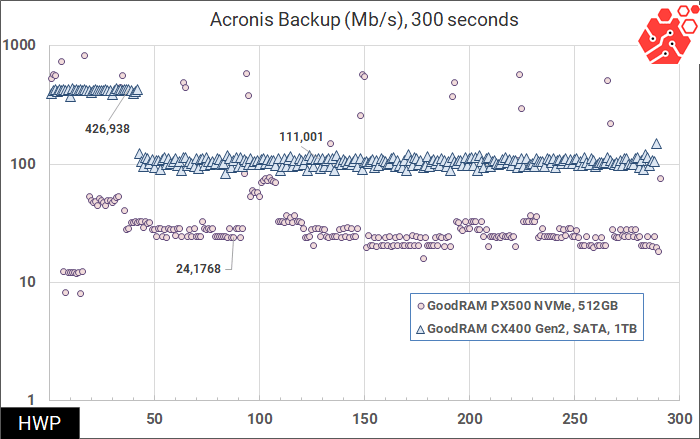
Here the recording goes in large blocks, and the GoodRAM CX400 Gen2 copes well with it, literally at the level of sequential recording speed.
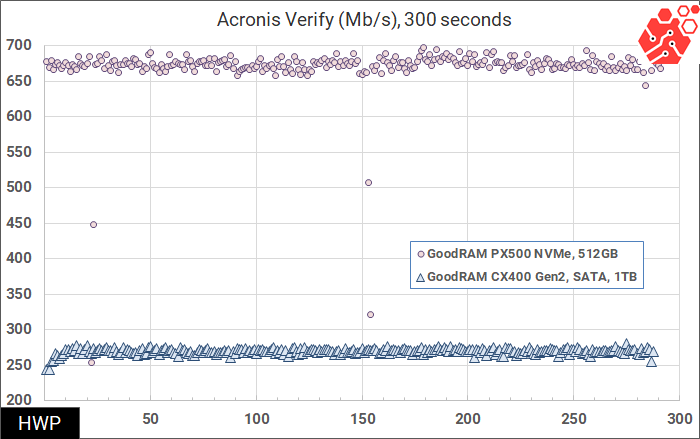
Of course, checking archives, for the most part, reads sequentially and in large blocks, but only partially. Here we state a stable speed without any surprises in the range of 250-280 Mb/s.

With the increase in the share of random reading, the speed naturally drops by 1.6 times, but for comparison, the NVME disk "fell" almost 3 times.
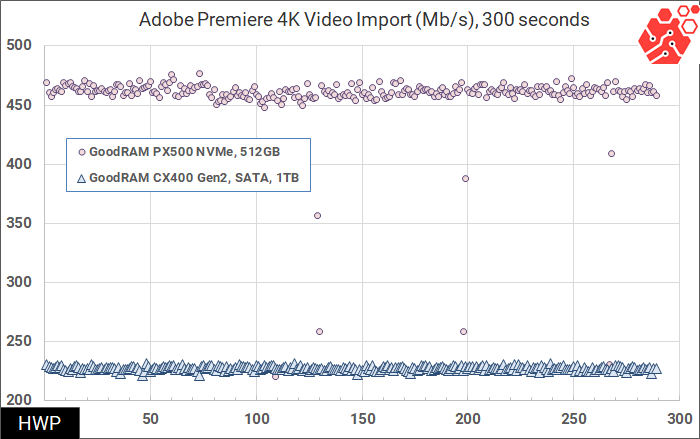
Almost the same level of 220 MB/s is maintained in the operations of reading large video files.
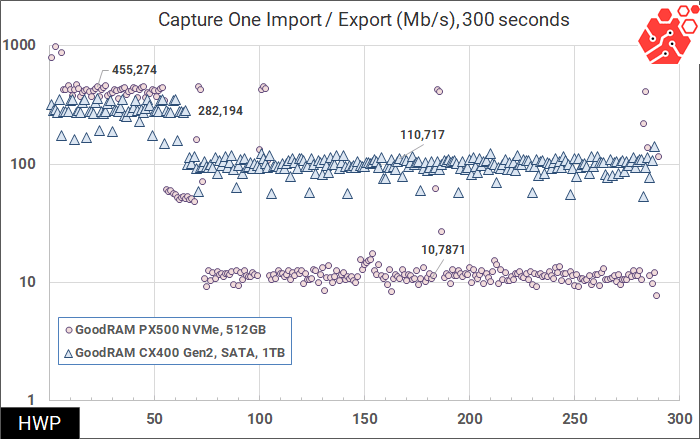
With simultaneous reading and writing, the determining factor is the operation of the SLC cache, which accelerates write operations. This is a rather difficult test for a home drive, and it surprises me how, throughout the entire testing time, the GoodRAM CX400 Gen2 kept its speed in the region of the permissible 100 MB/s.
Conclusions
Don't write off SATA drives: even budget models with 3D NAND memory are able to perfectly digest typical workloads, not to mention games. Most of the disk operations in such scenarios are implemented in the SLC cache area and have high speed with minimal response time. Where there is not enough SLC cache, the speed of the GoodRAM CX400 Gen2 is kept at an average level: faster than budget NVME drives, but slower than good NVME models with 4 NAND chips and a dedicated DRAM cache.
In general, I can say that the GoodRAM CX400 Gen2 is suitable for most household tasks, including working with multimedia programs, for games and daily office work.
Michael Degtjarev (aka LIKE OFF)
16/02.2022
















